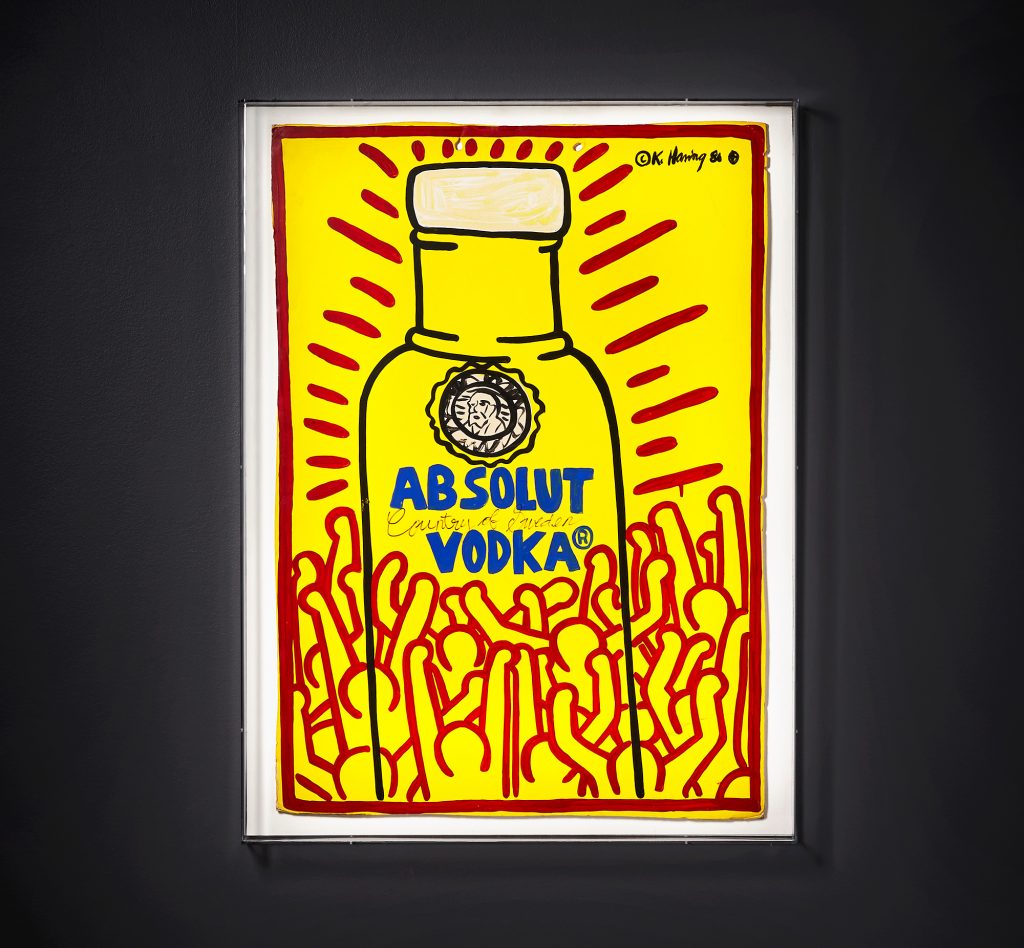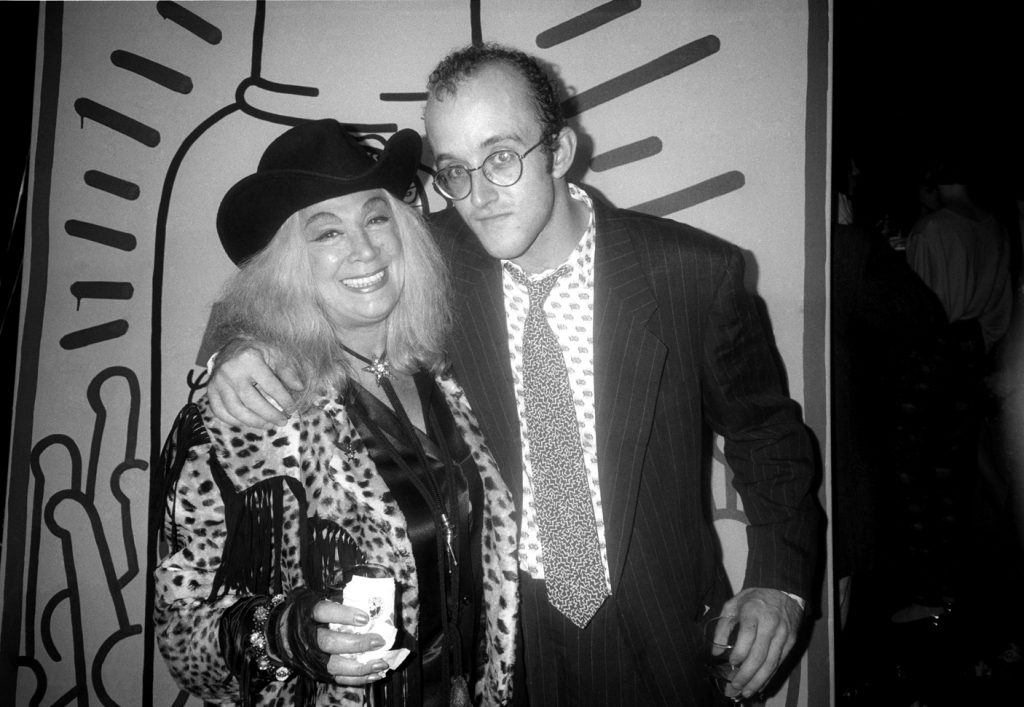
Keith Haring (1958-1990)
“Absolut Vodka”
Lot 654 Keith Haring (USA 1958‑1990). ”Absolut Vodka”. Signed and dated © K. Haring 86 ⊕. Acrylic and felt-tip pen on board, 95 x 67 cm.
Estimate
SEK 3.000.000 – 4.000.000
€ 290.000 – 386.000
Provenance
Acquired directly from the artist.
Christie’s, New York, Sale 7092 Part I, “Contemporary drawings, watercolors and collages”, 8 May 1990, cat. no. 227, illustrated in the catalogue p. 117.
A prominent Swedish Private Collection, acquired at the above sale.
Literature
Anneli Bäckman, Face it!: Absolut Art Collection, Spritmuseum, 2012, compare with “Absolute Haring” illustrated p. 53.
In context:
The American pop artist Keith Haring has become famous worldwide for his illustrative paintings and graffiti-inspired artworks. At a young age, Haring left his hometown in Pennsylvania for the metropolis of New York, a city that was formally vibrating of energy and characterized by open liberal values, sexual freedom and a ground-breaking creativity in the 1980s. Comparable to Paris in the early 1900’s, New York became the epicentre of avant-garde art and especially the American abstract movement and pop art – a sanctuary where the new art was allowed to grow on streets and squares.
The emerging pop and graffiti art was inspired by comic books, popular culture and mass production in the latter half of the 20th century and soon caught the interest of product companies. The Swedish The Absolut Company was one of the first companies to realize the potential of using Haring’s words ”art is for everyone” and the contemporary artists’ recognizable images in their campaigns. They often painted with strong colours and bold expressions, immediately catching the eye. The first artist who was commissioned to launch a campaign for Absolut Vodka was Andy Warhol, but he would hardly be the last. The year was 1986 and the advertising campaign with Warhol’s iconic painting ”Absolut Warhol” became known as one of the most successful commercial campaigns of the 20th century. After the collaboration, Warhol recommended a number of exciting artists for Carillon Importers CEO Michel Roux, who was in charge of launching Absolut Vodka in the USA. One of the artists Warhol recommended for future advertising campaigns was Keith Haring.
Haring, unlike most of the graffiti artists in New York, was an educated artist who signed up at The School of Visual Arts after his arrival in New York. Using art historical references and theories of conceptual art, he distinguished himself early among his contemporaries and succeeded in creating a recognizable non-verbal language that became synonymous with his artwork. Symbols such as the barking dog, crawling baby and the figure with stretched arms give motion and vitality despite simplified shapes and details. The language that he formed became a global movement; “A more holistic and basic idea of wanting to incorporate [art] into every part of life,” he explained, “less as an egotistical exercise and more natural somehow. I don’t know how to exactly explain it. Taking it off the pedestal. I’m giving it back to the people, I guess” (Keith Haring cited in: Daniel Drenger, Art and Life: An Interview with Keith Haring, Columbia Art Review, Spring 1988, p. 53). The inspiration for Haring’s artwork was taken from New York’s alternative art scene and the graffiti that adorned the streets outside his school hall, especially from artists such as Jean-Michel Basquiat and of course the master of pop art Andy Warhol. ”I also combined what happened at night with what happened at school. It was a way to claim my sexuality and force other people to handle it.” (K. Haring, cited in J. Gruen, Keith Haring, The Authorized Biography, 1991, p. 39).
Warhol was a great influence for the younger generation of artists in New York but also one of Haring’s close friends. This inspired Keith Haring’s collaboration with The Absolut Company and the performance of four monumental paintings with the iconic Absolut Vodka bottle in the center. Two of these works are owned by the Spritmuseum in Stockholm today and are part of the Absolut Art Collection, the auction’s painting ”Absolut Vodka” is probably a study to one of these; ”Absolut Haring”. The current work ”Absolut Vodka” executed in 1986 was most likely presented as a final proposal for The Absolut Company, and was carried out after it was approved in a larger final version on canvas with the exact same motif. The vision of the final work ”Absolut Haring” is in the auction’s painting clear, and when Haring painted it a second time in larger format very few changes occurred. The auction’s painting ”Absolut Vodka” is an acrylic and felt-tip pen on board. It was acquired directly from the artist by the previous owner.

Sylvia Miles and Keith Haring in front of ”Absolut Haring” at the Absolut Vodka party for Keith Haring at Whitney Museum of American Art.
When Haring performed ”Absolut Vodka”, the recognizable characters surrounding the Absolut Vodka bottle were drawn with thick lines and few details. In the earlier years of the decade, Haring used New York’s empty advertisements in subways and billboards for his drawings and filled them with colourful images, expressive symbols for freedom and an open society. The figures in the subways depicted the life of New York and were inspired by people he saw and met. When creating the painting “Absolut Vodka”, these figures were central. Together they form a crowd with their arms above the heads almost lifting the bottle towards the sky. The bottle is glowing, emphasized by Haring’s well-known rays – also seen in New York’s subway when Haring drew them on a commercial ban for Johnny Walker Whiskey. Keith Haring was a master of creating an unexpected expression through the use of simple lines; the viewer can almost hear the cheering crowd and feel the rhythm of the dance floor music. The painting brings the thought of a vibrant nightclub floor lit by disco lights to mind, an energetic colour explosion of Haring’s distinctive tones of flaming red and yellow with the well-known Absolut Vodka logo in contrasting blue. The work was later transferred to lithography.
It was in the graffiti art that Haring found his greatest inspiration and today, Keith Haring’s artistry marks a remarkable breakthrough on the international art scene. Undoubtedly, Haring’s brave expression paved way for allowing the urban art to enter established art galleries as well as the commercial market. We are very pleased to now be able to offer a piece of Swedish and American art history performed by one of the 20th century’s foremost artists.
Absolut Art Collection
– The result of worldwide collaborations
Spritmuseum, located in Galärskjulen at Djurgården in Stockholm, arranged an attentive exhibition with Keith Haring in 2016, ”Powerful Babies – The Impact of Keith Haring on Artists Today”. The works of contemporary and subsequent artists exhibited alongside Keith Haring’s four monumental canvases with the Absolut Vodka bottle as a central motif, created for Absolut Vodka’s launch on the American market during the 1980s. Today, two of these iconic paintings are owned by Spritmuseum in Sweden and are part of the Absolut Art Collection, together with about 850 artworks. They were all commissioned by The Absolut Company between 1986 and 2004 and are today historical witnesses of some of the 20th century’s most successful advertising campaigns.
The collection also contains the result of The Absolut Company’s first collaboration with an artist, Andy Warhol’s now iconic painting ”Absolut Warhol”, executed in 1986 and followed by a series of initiatives by international and Swedish artists. The story of how the cooperation with Andy Warhol began differ, one version of the story tells that Warhol proposed the idea to Carillon’s CEO Michel Roux at a dinner with the words ”I love the bottle. I want to do something with it.” Another version tells that Swedish entrepreneur Titti Wachtmeister, who worked in New York during this time, proposed the idea of a work of art with the Absolut Vodka Bottle for Andy Warhol. Regardless, he expressed his joy over the cooperation, and later recommended both Keith Haring and Kenny Scharf for The Absolute Company’s future campaigns. Later collaborations have involved Swedish and international artists and designers such as Helmut Newton, Dakota Jackson, Ed Ruscha, Annie Leibovitz, Dan Wolgers, Damien Hirst, Ola Billgren and David Shrigley, currently showing the exhibition Giant Inflatable Swan at Spritmuseum. Together, the artworks included in the Absolut Art Collection provides an insight into the trends, political fluctuations and emotional expressions that characterized the last decades of the twentieth century and the beginning of the 21st century.
The Swedish state sold Vin & Sprit AB in 2008 to French Pernod Ricard. In conjunction with the sale of Vin & Sprit, a motion was submitted to the Swedish parliament with the proposal that the extensive Absolut Art Collection should remain in state ownership and be transferred to an ”appropriate state museum before any sale of the company is actualized”. Absolute Art Collection was considered to be of unusual cultural and historical value for Sweden and was handed over after a parliamentary decision to Spritmuseum. Today the museum is operating as a foundation, but it was first established as a company museum for Vin & Sprit AB. Therefore, the collection remained in Sweden and is one of the country’s most significant collections today, including Swedish and international contemporary art, graphics, photography, sculpture, furniture, fashion and crafts. Common to all works is that they have been the basis for worldwide advertising campaigns for Absolut Vodka. Parts of the collection are constantly shown in Spritmuseum’s annual separate and group exhibitions.